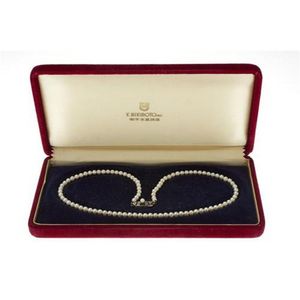Georgian Eye Brooch with Hand Painted Miniature
You must be a subscriber, and be logged in to view price and dealer details.
Subscribe Now to view actual auction price for this item
When you subscribe, you have the option of setting the currency in which to display prices to $Au, $US, $NZ or Stg.
- Georgian - As an English stylistic period, Georgian is usually taken to cover the period from George I (1714) to the Regency of Prince George (1811-20), although the period from 1800 to 1830 is sometimes designated as the Regency period. During the Georgian period the great English cabinetmakers and designers such as Chippendale, Hepplewhite, Adam Sheraton etc., were all active.
Therefore there isn't a single 'Georgian style' as such and to say something is 'Georgian', usually means it was made between 1714 and 1830. This assumes we discount George V and George VI, both being from the 20th century.
The styles popular at the time of each reign were:
George I (1714-1727) saw out the last years of the Baroque period.
George II (1727-1760) reigned during the Rococo period.
George III (1760-1820) saw the last gasp of the Rococo, all of the early Neo-Classic 'Adam style' and most of the later neo-Classic 'Regency style'.
George IV (Prince Regent 1820-1830)encompassed the last of the 'Regency' style.
William IV's reign (1830-1837) was something of a no man's land (stylistically) and he wasn't a 'George' anyway. He covered the last glimmerings of 'Regency' and the start of the 'Victorian' style. - Circa - A Latin term meaning 'about', often used in the antique trade to give an approximate date for the piece, usually considered to be five years on either side of the circa year. Thus, circa 1900 means the piece was made about 1900, probably between 1895 and 1905. The expression is sometimes abbreviated to c.1900.
This item has been included into following indexes:
- brooches, design or type
- brooches, gold - gold with seed pearls 1,011
- miniatures - portrait, in jewellery 109
Visually similar items

A fine engine turned sterling silver cigarette box, 1947 Birmingham, with maker's mark for Joseph Gloster Ltd, the rectangular hinged box with elegant concave sides, engine turned throughout with laurel bands to the lid and base and raised on petite splaye

A Mikimoto vintage pearl necklace, 4 4.4 mm round fine cultured pearls to a silver clasp with Mikimoto mark, length 42 cm, in fitted box.

A sterling silver and rosewood jewel box, the lid with applied sterling silver plaque having oval bead style decoration.

